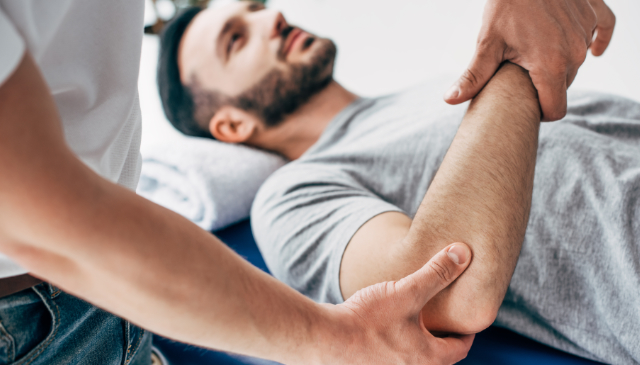News
Unlocking Relief From Elbow Pain With Hands-On Therapy and Exercise

Elbow pain can be a persistent and frustrating issue, often sneaking into one's daily routines with subtle discomfort that gradually worsens. For many, especially those suffering from lateral elbow tendinopathy–commonly known as tennis elbow–simple tasks like turning a doorknob or trying to open a jar end up becoming painful challenges. Tennis elbow affects a significant portion of the population, with estimates suggesting that 1–3% of people experience its bothersome symptoms at some point in their lives.
Understanding the complexity of elbow pain requires not only recognizing its symptoms, but also exploring the underlying causes and the latest advancements in treatment. Recent research shows that a multifaceted approach–combining manual therapy techniques like mobilization with targeted exercises–can offer superior outcomes compared to traditional methods. Following a comprehensive strategy can alleviate pain and also restore functional movement, thereby empowering patients to regain confidence and independence in their daily activities.
This article delves into the intricacies of tennis elbow, examining how innovative physical therapy interventions can significantly improve patients' recovery journeys. By exploring the science behind these techniques and their practical applications, we aim to provide a clearer understanding of how to effectively unlock relief for pain caused by tennis elbow.
Taking a closer look at tennis elbow
Tennis elbow manifests as pain and tenderness on the outer part of the elbow, precisely where the muscles responsible for extending your wrist and fingers attach to the upper arm. Overuse and repetitive strain–which are common in sports, certain occupations, and daily activities–lead to tiny tears in the tendons, causing inflammation and discomfort. Symptoms of tennis elbow often include:
- Persistent pain on the outer elbow that is worsened by wrist movements
- Weak grip strength, which makes it difficult to hold objects
- Discomfort during lifting, twisting, or gripping activities
- Morning stiffness or stiffness after periods of inactivity
As the condition progresses, it can become chronic, making management more challenging without intervention. Early diagnosis and treatment are therefore crucial to prevent long–term disability and to facilitate a quicker return to normal function.
Study shows that combining interventions leads to the best outcomes
With this in mind, researchers conducted a study to explore the synergy between Mulligan mobilization and eccentric exercise, two interventions that physical therapists frequently use when treating tennis elbow. Mulligan mobilization is a hands–on technique that involves gentle, sustained movements applied to the elbow while the patient actively moves their arm, which are intended to restore proper joint mechanics and reduce pain. Eccentric exercises for tennis elbow involve slowly lowering one's hand towards the palm after lifting it up, which promotes tendon healing and increases strength.
This study included 30 patients with tennis elbow who underwent either eccentric exercises alone (EE group) or Mulligan mobilization plus eccentric exercises (MWM group) over 4 weeks. The goal was to determine if adding MWM led to better outcomes in pain relief and functional improvement.
Results showed that both groups experienced significant improvements in pain and function after 4 weeks, but the MWM group reported much better outcomes than the EE group, with larger reductions in pain and greater functional improvements. The reason mobilization and eccentric exercises work so well together could be because their combination creates a therapeutic environment in which:
- Pain cycles break more quickly, which allows patients to engage more fully in their rehabilitation
- Movement patterns normalize as proper joint mechanics are restored
- Tissue healing accelerates through improved circulation and proper loading
- Patient confidence increases as they experience more immediate relief
- Exercise tolerance improves, enabling more effective strengthening of supporting muscles
This study further validates what the research consistently shows: combining manual therapy and exercise lead to superior outcomes than either approach alone for many conditions, including tennis elbow. That's why both interventions are typically included in a standard physical treatment program for tennis elbow.
Give us a call today!
As we mentioned above, failing to address tennis elbow early can lead to chronic pain, which is usually harder to treat. But early, evidence–based interventions like those described above can significantly shorten your recovery time, reduce the need for pain medications, and prevent long–term disability. That's why it's best to get started on a physical therapy program as early as possible to improve your chances of having a complete recovery.
Contact us today to begin your journey towards less pain from tennis elbow with a personalized physical therapy treatment plan! Or click here to dive deeper into the findings of the study featured in this blog.
Disclaimer:
The information in the articles, posts, and newsfeed is intended for informational and educational purposes only and in no way should be taken to be the provision or practice of physical therapy, medical, or professional healthcare advice or services. The information should not be considered complete or exhaustive and should not be used for diagnostic or treatment purposes without first consulting with your physical therapist, occupational therapist, physician or other healthcare provider. The owners of this website accept no responsibility for the misuse of information contained within this website.
